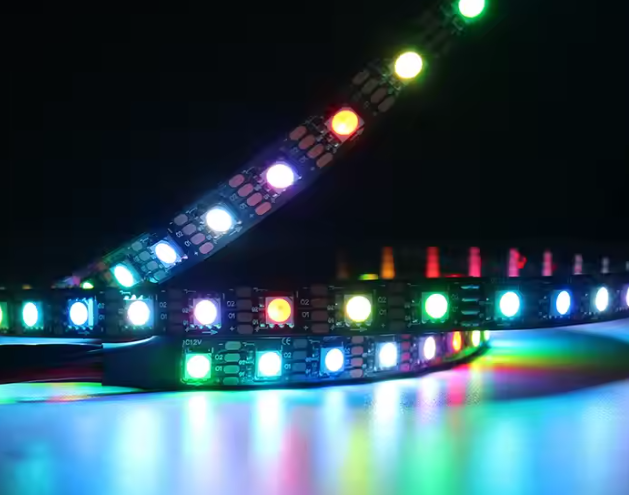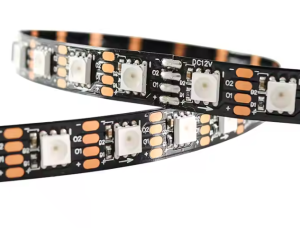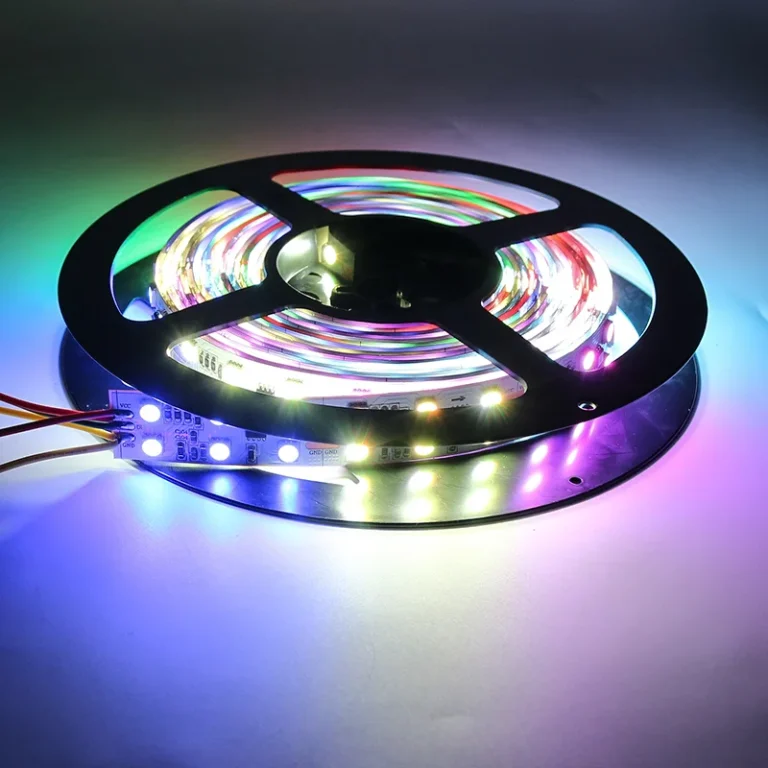What Is An Addressable LED Strip?
Definition and Features
Addressable LED strip lights are a kind of light strip technology that has the ability to control each individual LED within the strip independently. They can then be reused in a variety of colors and animations, making them very flexible for any purpose. For example, the SMD 5050 BGR LED strip has a beam angle of 120 degrees and utilizes the GS8208 IC chip making the LED strip have individually addressable features in each LED. Strips work with a voltage of DC12V, and various waterproof grades like IP20, IP65, IP67, and IP68 to choose from.
Applications and Benefits
Addressable LED strips are commonly used in decorative lighting, stage lighting, and architectural installations due to their ability to create dynamic visual effects. They offer flexibility in design as they can be cut at specific points, such as every 16.67mm in some models, allowing for customized lengths. Additionally, they can be used with controllers like SD card controllers or Arduino for precise control over lighting patterns.
Built-in IC vs. External IC
Characteristics of Built-in ICs
Internal ICs are embedded as part of the LED chip. This in turn increases the design compactness, as no extra component should be around the strip. A typical implementation would be to use SMD 5050 RGBW LEDs that have the SK6812 IC embedded, which reduces the number of required external components for a cleaner design.
Advantages and Disadvantages of External ICs
External ICs are separate from the LED package and require additional wiring to connect them to the LEDs. While they may offer more advanced features or higher power handling capabilities, they can also complicate installation due to the increased number of connections required. However, external ICs can be advantageous in scenarios where specific functionalities not available in built-in ICs are needed.
How Do Addressable LED Strips Work?
Technical Functionality
How Addressable LED Strips Work Although Addressable LED strips work on the same principle as individually addressable LED strips, they contain an integrated circuit (IC) that controls each separate LED on the strip. It gets signals from the controller that indicate what should each LED do (change color, change brightness, or turn off completely). This allows for complex light patterns and animations. This allows for complex light shapes and animations.
Control Mechanisms
These strips can be controlled with SD card controllers, Arduino systems, DMX decoders, or more sophisticated WiFi or Bluetooth controllers. Depending on the intricacy of the light effect and the required interaction, suitable controllers can be determined. Controller selection is dependent on the complexity of the light effect and the user interaction required.
Addressable LED Strip VS Non-addressable LED Strip
| Feature | Addressable LED Strip | Non-addressable LED Strip |
| Control | Individual control over each pixel | All LEDs change color simultaneously |
| Complexity | More complex installation due to individual wiring | Simpler installation |
| Flexibility | High flexibility with customizable patterns | Limited flexibility |
| Applications | Ideal for dynamic displays and animations | Suitable for static lighting applications |
| Cost | Generally more expensive due to advanced features | More cost-effective |
Types of Addressable LED Strip Lights
1. Single Signal Addressable LED Strips
Design and Functionality
Single signal addressable strips use one data line to transmit signals across all LEDs in sequence. This design simplifies wiring but may limit some advanced functionalities compared to dual-signal systems.
Common Uses
These are often used in straightforward applications where basic animations suffice without needing redundancy or error correction features.
2. Dual Signal Addressable LED Strips
Design and Functionality
Dual signal strips feature two data lines which provide redundancy; if one line fails, the second ensures continued operation. This enhances reliability, especially in critical applications.
Common Uses
They are preferred in environments where reliability is paramount such as commercial installations or large-scale events.
3. Breakpoint Resume Addressable LED Strips
Design and Functionality
Breakpoint resume technology allows these strips to continue functioning even if some sections fail due to damage or other issues. This is achieved by maintaining signal integrity despite interruptions.
Common Uses
This type is particularly useful in long installations where maintaining continuous operation is critical despite potential damages along certain sections of the strip.
These and additional models that utilize these technologies (in this case GS8208 Pixel series) from Shiji Lighting ensure that even if a pixel does falter, the signal transfer can continue without issue—even if two consecutive adjacent LEDs experience failure; a solid assertion of practical efficacy. The GS8208 Pixel from Shiji Lighting not only features those technologies but also features one other great benefit, loss of signal on a given segment will not occur unless 2 LED adjacent fail (not just 2), making these pixels much more robust in the field!
Can You Cut Addressable LED Strips?
Cutting Guidelines
These LED strips are cuttable with addressable LEDs which allows for fitting into lengths more specific to an installation and applications. The cutting lines are often marked on the strip, telling you where you can cut safely without ruining the circuit. As with the GS8208 LED strip, every 16.67mm is a cutting line, which can be accurately customized according to different application scenarios for length.
Considerations Before Cutting
Many addressable LED strips have points where you can easily cut the circuit, however, it is very important to think about how this will affect the electrical circuit, in the same way as the power supply and controller need to be able to work with the new range. This involves checking that each piece post cut/path still works, and whether it has a complete circuit path and connection points to reconnect back into the circuit.
How Do You Connect Addressable LED Strips?
Connection Methods
When connecting addressable LED strips you have a couple of options which include connectors or soldering wire to create a stable electrical connection between segments. Typically both ends of a strip feature 4-pin JST SM connectors, for ease of connection. These connectors are commonly found in devices like the GS8208 series from Shiji Lighting, allowing for easy snap-on and snap-off.
Tools Required for Connection
Other equipment needed for the connections of addressable LED strips are wire cutters, a soldering iron (if you require soldered connections), heat shrink tubing to insulate the connections and multimeters to test continuity and voltage values. These tools also secure and ensure that the lights are working properly. They assist in ensuring that the connection is secure and that the lighting arrangement works properly.
How Do You Control Addressable LED Strips?
Control Options Available
Addressable LED strips offer various control options ranging from simple remote controls to sophisticated systems like Arduino or DMX decoders. Each method provides different levels of interaction and customization capabilities based on user requirements.
Software and Hardware Solutions
Other software solutions are just apps or custom programming environments like Arduino IDE used to develop special light patterns. Hardware solutions could be SD card controllers or WiFi modules that will allow the device to wirelessly control light effects. The decision of solution includes software and hardware depending on how complicated the animations you wish to implement and also your sophistication with user technologies.
How to Install Addressable LED Strips?
Step-by-Step Installation Guide
Preparation Steps
- Plan Layout: Determine where you want to install the strips and measure the required lengths.
- Gather Materials: Ensure you have all necessary components including power supplies, controllers, connectors, and mounting accessories.
- Test Components: Before installation, test each component individually to confirm they function as expected.
Installation Process
- Cut Strips: If needed, cut the strips along designated lines ensuring no to damage any electrical paths.
- Connect Segments: Use connectors or solder wires between segments ensuring secure electrical connections.
- Mount Strips: Attach strips using adhesive backing or mounting clips provided with waterproof versions like IP65-rated models.
- Connect Power Supply: Ensure correct voltage input (e.g., DC12V for GS8208 series) is supplied to avoid damaging the LEDs.
- Configure Controller: Set up your chosen controller system according to manufacturer instructions ensuring compatibility with your specific IC type.
FAQs
Q1: How to Know if an LED Strip Light is Addressable?
An addressable LED strip will typically feature an integrated circuit (IC) chip that allows individual control over each LED on the strip. This capability distinguishes them from non-addressable strips where all LEDs behave identically.
Q2: Why Do Addressable LED Strips Have So Many IC Types?
Different IC types, e.g., WS2811, APA102C (or SK6812), have different characteristics with respect to the data transfer method (single, dual signal), redundancy features (breakpoint resume), or compatibility with controllers or programming environments. This variety in IC type gives the user the flexibility to select a solution locally optimized for the specific application needs; for example, reliability levels or lighting effect.




